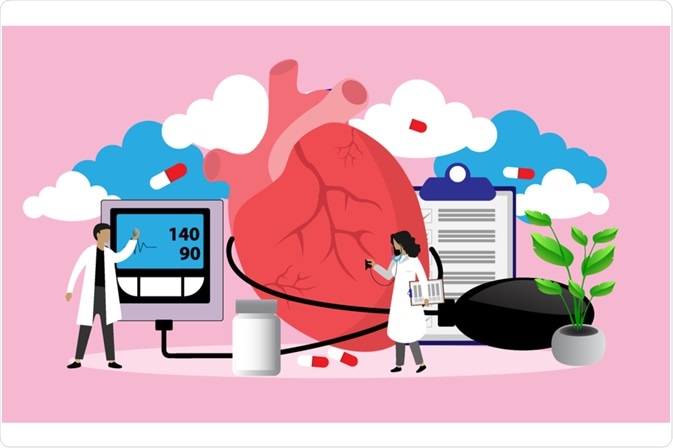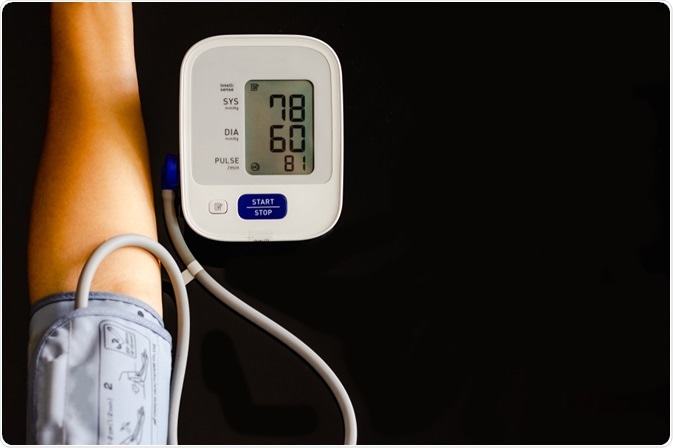Blood pressure is the force exerted by circulating blood pushing against the walls of the arteries.

Image Credit: Dapitart / Shutterstock.com
Introduction to blood pressure
Two different types of blood pressure are of clinical importance. These include systolic blood pressure, which is a measure of blood pressure while the heart is beating, and diastolic blood pressure, which is a measure of the relaxed heart between heartbeats. Contrary to hypertension, which is a term used to describe high blood pressure, hypotension represents abnormally low blood pressure.
In a healthy person, low blood pressure without any signs or symptoms is not a problem and no treatment is necessary. On the other hand, if the hypotension is associated with some underlying disease process (e.g. severe blood loss), it is critical to find and treat the condition causing the hypotension. Measuring blood pressure for the diagnosis of hypotension should follow recommended procedures; otherwise, incorrect diagnoses can ensue and result in incorrect treatment and cardiovascular events.
Blood pressure measurement
Blood pressure is measured by the century-old conventional sphygmomanometry and by auscultation of the Korotkoff sounds or pulse wave. Typically, these techniques involve the use of an inflatable cuff that provides blood pressure values that are expressed in units called “millimeters of mercury” (mmHg).
It should be noted that the blood pressure measurement process itself is prone to errors, which may arise in the observer, the subject, the device, or in the overall application of the technique.
Systematic error in the auscultatory blood pressure measurement can be a result of inadequate mental concentration, observer prejudice or bias, poor hearing, or confusion of visual and auditory cues. Another major drawback of sphygmomanometric measurement stems from the fact that blood pressure is highly variable and often exhibits large diurnal fluctuations.
The automated devices that are currently available to the public have been designed for the self-measurement of blood pressure, all of which employ the oscillometric technique. There are three categories of these devices that are currently available, which include those that measure blood pressure on the finger, the wrist, and the upper arm, the latter being most accurate. Self-measurement of blood pressure is currently performed mostly by patients on their own initiative with the use of devices bought on the free market.

Image Credit: NIKCOA / Shutterstock.com
Newer techniques, such as ambulatory blood pressure monitoring, are slowly being embraced in clinical medicine as a way to overcome some of the limitations associated with conventional sphygmomanometry. Ambulatory blood pressure monitoring enables recording of the blood pressure throughout the day when patients are engaged in their normal activities; therefore, it can provide a sound estimate of their blood pressure within a 24 hour period.
Definition of hypotension
The mechanisms involved in the regulation of blood pressure are divided into two broad categories that include short-term and long-term regulation. Short-term regulation is dominantly neural and involves baroreceptor reflex, chemoreceptor reflex, stress relaxation, and capillary fluid shift. Long-term regulation is hormonal and balances the effects of the sympathetic and parasympathetic nervous systems.
It is difficult to define hypotension in absolute terms, as there is considerable variability in systemic blood pressure values. For someone with a usual blood pressure of 140/85 mmHg, a value of 90/60 mmHg can be regarded as hypotensive. Still, when systolic pressure is less than 80 mmHg and diastolic pressure less than 50 mmHg, a diagnosis of hypotension can be made.
Many people have blood pressure recordings that decline below the normal range over the course of the day, most often during sleep. In the absence of cardiovascular disease, people with lower blood pressure values are thought to be protected by this condition.
When hypotension is associated with significant symptoms, reduced perfusion to an organ, or some underlying disease process, hypotension can be considered clinically important. The condition may be temporary or chronic, but it can also evolve into circulatory shock. Several cardiac conditions are associated with hypotension.
References
Further Reading
Last Updated: May 8, 2021